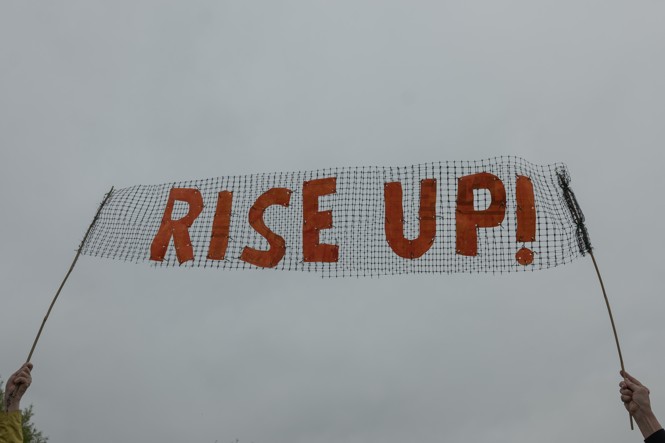The Cardboard-Carrying Opposition Arrives
The “Hands Off” protest in Washington, D.C., drew thousands of people with a lot of feelings—but as-yet-inchoate anger at the Trump administration.

Photographs by Caroline Gutman
The opposition arrived in a flurry of painted cardboard.
Until this week, the 11th of Donald Trump’s second presidency, the resistance has not exactly been upper-case R. Any show of dissent by Democratic leadership has been virtually nonexistent, and protests against Trump’s policies have been small and sporadic. Citizen frustration with the new administration has registered nationally as little more than a distant rumble.
Today’s “Hands Off” protest, organized by a coalition of left-wing groups, was an attempt to raise the volume.
People carted their megaphones and rainbow flags to more than 1,200 sites across the country today—in D.C., of course, but also in Helena, Montana; Daytona Beach, Florida; and Dubuque, Iowa. The events spanned all 50 states, the organizers said, plus a few more exotic locales, such as Guadalajara, Lisbon, and Paris. Washington had expected to draw about 10,000 protesters; in the end, several times that showed up.
In interviews with some of those gathered today on the National Mall, demonstrators told me that they were under no illusion that Trump or Elon Musk would be much swayed by their anger or creative signage. The point, they said, was to show the rest of America that the opposition exists—and is widespread. “This is not for them,” Gina King, a retired teacher from New York City, told me. “This is for us.”
The first mass protest of this administration was well timed. The week began with Cory Booker’s record-breaking 25-hour tirade against Trump from the Senate floor. The monologue accomplished nothing tangible—though it threw Booker’s Oura-ring readings out of whack—but it was a welcome stunt for voters who have been craving louder public rage against the administration’s actions. (What says outrage more than a man willing to hold it for 25 hours?) Then, on Tuesday night, Democrats in Wisconsin won the first electoral test of Trump’s second presidency, by defeating a state-supreme-court candidate backed by Trump and $20 million from Musk. Also on Tuesday, one of the largest mass layoffs of federal workers to date began, when employees at the CDC and the FDA were dismissed. Finally, on Thursday, Trump’s tariffs sent Americans’ retirement savings plunging, triggered manufacturer layoffs, and forced CNBC to bring its bear-market graphic out of hibernation.
King, the retired teacher, carried a sign thanking Booker and Wisconsinites for their efforts in the fight against Trump. She protested the president during the Women’s March in early 2017, but this political moment is different, she told me. “It feels more desperate,” she said. “We should all be standing in front of the Supreme Court every day, in front of the National Institutes of Health every day.”
Half a dozen federal employees spoke with me at the protest, but none wanted to share their full name for fear of retribution from the Trump administration. “I’m here because I feel powerless,” said a man named Edward, who had just been forced out of his longtime government job. He carried a sign mocking the “five bullet points” that federal employees are now required to submit weekly to Musk’s DOGE.
“In the original Women’s March, we were very concerned with women’s rights, but now he’s touching all areas,” Tracie, an employee in the Department of Veterans Affairs, told me. She was willing to risk her job to show up at the protest, together with her daughter and granddaughter, she told me, because she wants America to see her anger. “The administration is completely discounting us. They’re saying we’re bought, we’re paid for, we’re bused in.” But the opposition to Trump is real, she said. “We are out here.”
On the Mall, it was difficult to pinpoint a chief complaint or singular demand. Hands off what, exactly? I asked.
There were so many things to be furious about. No single piece of cardstock could contain it all. People carried posters about the administration’s deportation of immigrants and dissident students; Laura Loomer’s Oval Office influence; Musk’s taking a chain saw to the federal government; the return of preventable diseases; the technological ineptitude of Trump’s defense officials; and attacks on abortion rights.
Many of those I spoke with cited creeping fascism. “There’s been a total disregard of habeas corpus,” Larry Bostian, a retiree from Silver Spring, Maryland, told me. “Democracy is in a death spiral.” Paul Singleton, an Air Force veteran from Stafford, Virginia, agreed. “I used to wonder, how did Hitler do what he did?” he said. “When Trump got into office and started appointing all these people, I stopped.”
Given the stakes, people wanted to know, where was Democratic Party leadership? Katrin Hinrichsen, a retired computer engineer from Connecticut, had brought a few signage options, including one that read Time to CHUCK Schumer. “I want some effective leadership of the Democratic minority,” she told me.
A few Democratic lawmakers addressed the rally in D.C., including Representatives Jamie Raskin of Maryland and Ilhan Omar of Minnesota. They were speaking on a stage somewhere amid the dense crowd gathered at the base of the Washington Monument. But most people couldn’t hear them; some had no idea there was a stage at all. Instead, parts of the rally devolved into a kind of hippie picnic, where sign carriers chatted in circles or plopped on the grass to eat sandwiches. One woman handed out nuts and dried fruit: “Cashews, anyone?” Another laughed with her friends—“The last time I felt safe in a crowd this big was at a Taylor Swift concert!”
“We’ve been scattered; we’ve been demoralized,” Bostian, the retiree from Silver Spring, told me, looking at the sea of people around him. “But this is awesome.”
The 2017 Women’s March connected protesters who kept in touch, established “Resistance” groups in their hometowns, and eventually helped elect a wave of new Democrats during the 2018 midterms. Today’s protesters think that they can do it again. They just need the rest of America to hear them.










